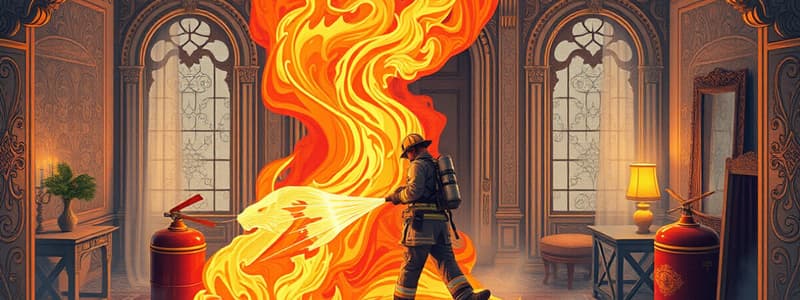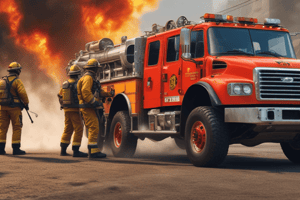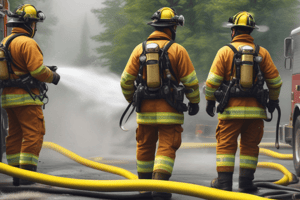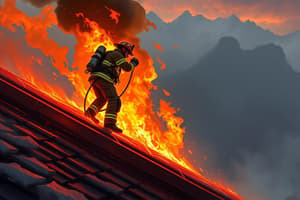Podcast
Questions and Answers
Which stage of fire behavior is characterized by light heat and smoke conditions and the fire being confined to its original area?
Which stage of fire behavior is characterized by light heat and smoke conditions and the fire being confined to its original area?
- Incipient stage (correct)
- Transition stage
- Free-burning stage
- Smoldering stage
What should firefighters always wear when approaching a fire, regardless of the stage?
What should firefighters always wear when approaching a fire, regardless of the stage?
- Lightweight uniforms
- Fire-resistant gear
- Casual clothing
- Full protective clothing (correct)
In the free-burning stage, what significant change occurs in the room conditions?
In the free-burning stage, what significant change occurs in the room conditions?
- Room temperature drops significantly
- Room becomes more oxygen-rich
- Ceiling temperatures rise rapidly (correct)
- The fire is completely extinguished
What is the main advantage of using the direct method of attack during the incipient stage?
What is the main advantage of using the direct method of attack during the incipient stage?
Why should firefighters to stretch a 1 3/4-in. handline during the incipient stage?
Why should firefighters to stretch a 1 3/4-in. handline during the incipient stage?
What can significantly shorten the time frame for safely approaching a fire?
What can significantly shorten the time frame for safely approaching a fire?
Which is not a method of attack?
Which is not a method of attack?
In the event of a potential flashover during the free-burning stage, what should firefighters be cautious of?
In the event of a potential flashover during the free-burning stage, what should firefighters be cautious of?
What is the primary function of an engine company in firefighting operations?
What is the primary function of an engine company in firefighting operations?
Why is interior firefighting considered an advancement over previous methods?
Why is interior firefighting considered an advancement over previous methods?
What did Chief Fred Gallagher emphasize about firefighting priorities?
What did Chief Fred Gallagher emphasize about firefighting priorities?
What is one of the major challenges faced by engine companies during structural fires?
What is one of the major challenges faced by engine companies during structural fires?
In addition to extinguishing fires, hose streams are also used for which secondary purpose?
In addition to extinguishing fires, hose streams are also used for which secondary purpose?
What kind of fires presented difficulties for traditional firefighting methods before advancements were made?
What kind of fires presented difficulties for traditional firefighting methods before advancements were made?
What does the concept of 'putting the fire out' suggest about engine company tactics?
What does the concept of 'putting the fire out' suggest about engine company tactics?
Why might an engine company have to operate within specific guidelines during firefighting?
Why might an engine company have to operate within specific guidelines during firefighting?
Which factor can complicate efforts to extinguish a fire according to the content?
Which factor can complicate efforts to extinguish a fire according to the content?
What is a primary concern when firefighters arrive at a ventilation-limited fire?
What is a primary concern when firefighters arrive at a ventilation-limited fire?
Which phase of a fire is characterized by a shortage of oxygen despite the presence of unburned fuel?
Which phase of a fire is characterized by a shortage of oxygen despite the presence of unburned fuel?
When arriving at a multistory building fire, what should be quickly examined?
When arriving at a multistory building fire, what should be quickly examined?
How has modern fire behavior changed with the evolution of building materials?
How has modern fire behavior changed with the evolution of building materials?
What key task should the nozzle team complete before starting their attack?
What key task should the nozzle team complete before starting their attack?
What might indicate that a fire has gone through the incipient and free-burning phases before the firefighters arrive?
What might indicate that a fire has gone through the incipient and free-burning phases before the firefighters arrive?
What is a significant consequence of opening a door in a ventilation-limited situation?
What is a significant consequence of opening a door in a ventilation-limited situation?
Why is it essential to locate the stairwell and escape routes when approaching a fire?
Why is it essential to locate the stairwell and escape routes when approaching a fire?
What contributes to the rapid decline in temperature during a fire in a ventilation-limited phase?
What contributes to the rapid decline in temperature during a fire in a ventilation-limited phase?
What is the maximum length of hose typically required for most residential structures?
What is the maximum length of hose typically required for most residential structures?
For ground floor fires, locate the spare hose outside the structure unless?
For ground floor fires, locate the spare hose outside the structure unless?
What is the recommended position for members of the nozzle team?
What is the recommended position for members of the nozzle team?
Where should spare hose be located for ground-floor fires?
Where should spare hose be located for ground-floor fires?
What is the safe area when dealing with multistory buildings?
What is the safe area when dealing with multistory buildings?
What weight is typically associated with a charged 1 3/4 inch hose compared to a dry length?
What weight is typically associated with a charged 1 3/4 inch hose compared to a dry length?
What is the primary reason firefighters should not enter the immediate fire area without water?
What is the primary reason firefighters should not enter the immediate fire area without water?
How should members position themselves when entering?
How should members position themselves when entering?
What does proper preparation of the nozzle team include?
What does proper preparation of the nozzle team include?
What is the primary reason firefighters should avoid getting too close to the seat of the fire when applying water?
What is the primary reason firefighters should avoid getting too close to the seat of the fire when applying water?
Why is it important for the nozzle operator to ensure the nozzle is slightly cracked before charging the line?
Why is it important for the nozzle operator to ensure the nozzle is slightly cracked before charging the line?
What should the nozzle operator primarily wait for before opening the line on a fire?
What should the nozzle operator primarily wait for before opening the line on a fire?
What is the recommended position for firefighters when advancing a flowing handline?
What is the recommended position for firefighters when advancing a flowing handline?
In which situation should firefighters consider getting very close to the fire?
In which situation should firefighters consider getting very close to the fire?
What should a firefighter assess before committing to a location for hose application?
What should a firefighter assess before committing to a location for hose application?
What is a common error among firefighters regarding their tactics at fires?
What is a common error among firefighters regarding their tactics at fires?
What reaction should the nozzle operator listen for when advancing in zero visibility?
What reaction should the nozzle operator listen for when advancing in zero visibility?
Which factor is NOT typically considered by fire officers when determining hose attack strategies?
Which factor is NOT typically considered by fire officers when determining hose attack strategies?
How should firefighters ideally behave when previous tactics are ineffective?
How should firefighters ideally behave when previous tactics are ineffective?
Up until the 19th century what was firefighting often limited to?
Up until the 19th century what was firefighting often limited to?
Each stage is characterized by differences in ____ temperature and _____ compositions
Each stage is characterized by differences in ____ temperature and _____ compositions
In a well involved room, ceiling temps can reach more than ____ degrees and large volumes of smoke are common
In a well involved room, ceiling temps can reach more than ____ degrees and large volumes of smoke are common
Flashcards
Aggressive Firefighting Tactics
Aggressive Firefighting Tactics
A modern firefighting approach focusing on aggressive tactics to extinguish fires quickly, moving beyond just protecting exposures or removing fuel.
Historical Challenges in Firefighting
Historical Challenges in Firefighting
The challenges faced in the past, like reaching fires in cellars or large structures, have been overcome with advanced techniques for more effective interior firefighting.
Engine Company Responsibilities
Engine Company Responsibilities
Engine companies are responsible for directly attacking fires, primarily by using water to extinguish flames.
Hoseline Management Importance
Hoseline Management Importance
Signup and view all the flashcards
Fire Behavior Stages
Fire Behavior Stages
Signup and view all the flashcards
Fire Attack Method Selection
Fire Attack Method Selection
Signup and view all the flashcards
Incipient Stage
Incipient Stage
Signup and view all the flashcards
Modern Materials Ignition
Modern Materials Ignition
Signup and view all the flashcards
Free-Burning Stage
Free-Burning Stage
Signup and view all the flashcards
Ventilation-Limited Conditions
Ventilation-Limited Conditions
Signup and view all the flashcards
Building Layout Awareness
Building Layout Awareness
Signup and view all the flashcards
Nozzle Team Responsibilities Upon Arrival
Nozzle Team Responsibilities Upon Arrival
Signup and view all the flashcards
Structural Awareness for Approach
Structural Awareness for Approach
Signup and view all the flashcards
Thermal Imaging Camera Use
Thermal Imaging Camera Use
Signup and view all the flashcards
Hose Length Preparation
Hose Length Preparation
Signup and view all the flashcards
Hose Staging for High Floors
Hose Staging for High Floors
Signup and view all the flashcards
Safe Hose Charging
Safe Hose Charging
Signup and view all the flashcards
Rollover Warning Sign
Rollover Warning Sign
Signup and view all the flashcards
Tactical Mindset
Tactical Mindset
Signup and view all the flashcards
Nozzle Team Readiness
Nozzle Team Readiness
Signup and view all the flashcards
Safe Hoseline Maneuvering
Safe Hoseline Maneuvering
Signup and view all the flashcards
Water Application Strategy
Water Application Strategy
Signup and view all the flashcards
Firefighting Flexibility
Firefighting Flexibility
Signup and view all the flashcards
Continual Reassessment
Continual Reassessment
Signup and view all the flashcards
Direct Fire Attack
Direct Fire Attack
Signup and view all the flashcards
Indirect Fire Attack
Indirect Fire Attack
Signup and view all the flashcards
Combination Fire Attack
Combination Fire Attack
Signup and view all the flashcards
Flashover
Flashover
Signup and view all the flashcards
Smoldering Stage
Smoldering Stage
Signup and view all the flashcards
Study Notes
Engine Company Operations Overview
- Modern firefighting prioritizes aggressive tactics to extinguish fires, moving beyond just protecting exposures or removing fuel.
- Historical challenges included reaching fires in cellars and large structures; advancements enable more effective interior firefighting.
- Engine companies are responsible for attacking fires directly, with water application being the primary method for extinguishing flames.
- According to Chief Gallagher, effectively putting out the fire improves overall conditions, underscoring the importance of hoseline management.
Importance of Fire Behavior Knowledge
- Fire behavior is categorized into three stages: incipient, free-burning, and smoldering.
- Each stage exhibits different temperature levels and atmospheric conditions, influencing tactical response.
- The selection of attack methods (direct, indirect, combination) is determined by the specific fire conditions and stage.
Incipient Stage
- Characterized by a small fire with light smoke; conditions may allow close approach for direct attack.
- Early intervention using hand extinguishers can prevent escalation; caution is necessary due to rapid ignition potential of modern materials.
Free-Burning Stage
- Intense heat and high smoke volumes indicate a fire potentially reaching flashover.
- Modern structural insulation and synthetic fuels often lead to ventilation-limited conditions before firefighters arrive.
- Knowledge of building layout and potential hazards aids effective firefighting strategy, especially in multi-story structures.
Tactical Considerations Upon Arrival
- Nozzle teams should locate and account for occupants, gather valuable fire situation information, and assess alternate escape routes.
- Structural layout awareness enables better decision-making on the approach to the fire area.
- Utilize thermal imaging cameras to detect the fire's location in low visibility.
Hose Management
- Ensure adequate length of hose is prepared for entry into the fire area, based on structure size and fire location.
- For higher floors, stage hoses below the fire to avoid risks from potential fire spread.
- Nozzle teams must charge lines only in safety; avoid rushing into visible fire without sufficient water supply.
Warning Signs and Safety Protocols
- Recognize signs of impending flashover, such as rollover, requiring immediate water application to ceiling areas.
- Employ a tactical mindset; adapt strategies based on the unique fire conditions rather than defaulting to past experiences.
Nozzle Operations
- Maintain readiness upon entering the fire area; bunker gear should be secure and hoses appropriately flaked.
- Effective hoseline maneuvering entails advancing cautiously while staying low to reduce burn risks on exposed skin.
- Water application should be reserved for visible flames unless extreme heat necessitates action despite limited visibility.
Final Notes
- The variability of fire dynamics necessitates flexible tactical planning and real-time risk assessment.
- Continuous reassessment and adjustments based on the fire's behavior are crucial for firefighter safety and effectiveness.
Studying That Suits You
Use AI to generate personalized quizzes and flashcards to suit your learning preferences.




